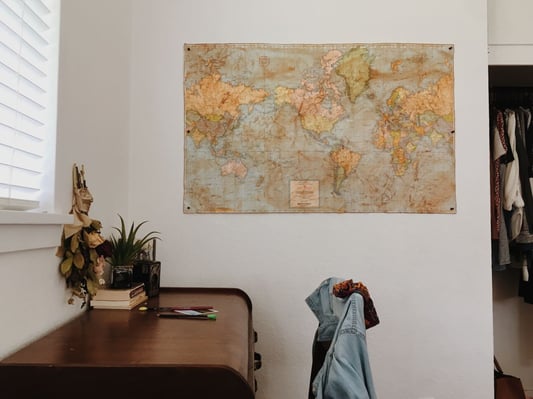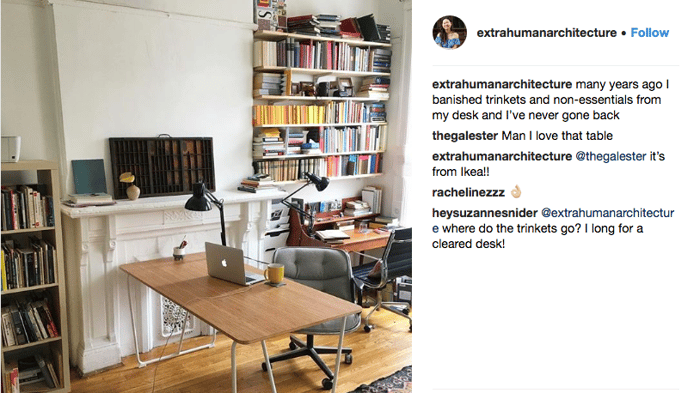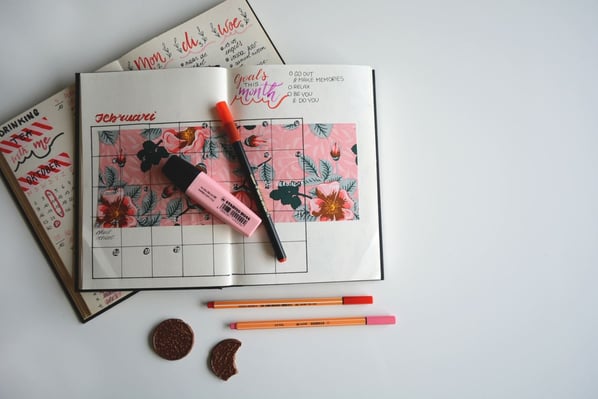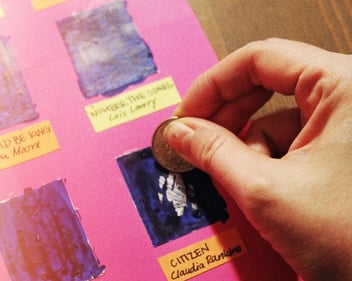by Lisa Hiton

From Marie Kondo’s “KonMari method” to Meik Wiking’s The Little Book of Hygge, everyone under the sun has an opinion about how the way we keep our homes can impact our inner life––for better or for worse. The dogmas in both of these books can help us writers do a true spring cleaning of our desks and ourselves, bringing us to clean, blank pages to write upon.
DECLUTTERING & ORGANIZING
Clutter is a controversial topic among writers. In one sense, the need to hoard makes sense––that every scrap of paper you’ve ever jotted a phrase on may be needed to win your Pulitzer someday. And yet, as the piles and notebooks amass, there is a sense of heaviness that can burden a writer by preventing the blankness necessary for new, riveting ideas.
A poet I admire, Wendy Xu, recently posted a photo of her desk on Instagram. As you can see, her desk is a simple work table, with absolutely no storage units. That includes what’s on the table itself. She writes: “many years ago I banished trinkets and non-essentials from my desk and I’ve never gone back”.

The desk is an inspiration. Especially as we write creatively, that pile of books we use for school can get in the way. Not only does it clutter the physical space of the desk, but it clutters the space of the mind with burdens––reminders to do homework, to peruse through that book for a quote you wanted, etc. If every time you began to write, you sat down to a space as blank as the new page of work you hope to make, your mind will get used to the routine, allowing the necessary freedoms of unburdening granted by decluttering. This is not limited to just the physical pile-up of other distractions and things to read, but also the ways our technologies clutter our minds and work space. So, dear writers, this season, prepare to close your tabs and put your phone in plane mode as you begin your spring cleaning.
Marie Kondo’s book The Life-Changing Magic of Tidying Up: The Japanese Art of Decluttering and Organizing, outlines rules that can be applied to the writer’s desk. Tidying should be done with great seriousness. The procedure for tidying should be followed, despite your own hopes and temperaments. The process is as follows:
- Tidy by category, not by room. For writers, this entails two key categories: books and papers. As daunting as it may be, in order to properly clear out that which is extraneous, you have to gather ALL of the books you own––regardless of what room they may live in. The cardinal rule of the KonMari method: an object must generate joy to merit the space it takes up. As for papers, you’ll need to include term papers, notebooks, diaries, and the rest. Kondo suggests that there are only three piles of paper worth keeping: 1) Frequently used papers 2) Less frequently used papers 3) Things to save indefinitely. It’s important to go through your works saved on your computer as well. Otherwise there will never be room for new works, let alone a clear way to find them.
- Start by discarding completely. As you start to go through each category, all of this new space will excite you. You’ll want to get it set up right away. But in order to have the full cleansing experience, you’ll have to first donate the books and recycle the papers you no longer need.
- Get organized before you get going. Now that you’ve gone through all of your things, the remaining items need to be placed carefully in your space or on your desk. There shouldn’t be a haphazard pile of writing implements, but rather, the one that you need right now should be out and available. You don’t need all of your electronics out and plugged in, just the one you plan to type on. And so forth. If you dream big like Wendy Xu, everything will be gone so that each time you come to write, you bring only what you need for that writing period with you. And when that time is over, you’ll clear the desk again. This way, no stack of books or papers piles up in the space of your writing. And thus, the mind can stay clear and ripe for new ideas.
THE ART OF CLUTTER
For some of you, the Kondo school of tidying may seem overwhelming and strict. The Hygge idea of coziness may suit you better. Hygge is a Danish word that captures the feeling of coziness. For Danes, this idea braids itself through every aspect of life––enjoying a meal, being with friends, being alone, and the way one feels in their home. The hygge way of life may include things like enjoying a cup of tea, wearing your favorite yoga pants, sitting near a fireplace, boardgames, lit candles, crocheting, stovetop popcorn––anything that causes that peaceful feeling of coziness to arise in you, really.
Similar to Kondo’s school of thinking, the hygge lifestyle is all about keeping things simple. As that translates to the writing life, you may need to devise a writing space that has just a bit of lived-in coziness versus the minimalist approach described by Kondo. For example, Wendy Xu’s desk may have nothing on it, but you’ll notice the desk is placed near a decorative mantle and fireplace. The backdrop of her desk space includes a wall of books that are arranged by color. There is a coziness and lightness to this combination of objects and clarity that resonates for a writer’s needs and loves.
So now that your space is clear, what objects spark the specific inspiration and feeling of coziness needed for writing? For example, does a potted succulent bring you a mental connection with nature that draws you into ideas? Are there certain colors that bring you peace and calmness? Here are some ways to consider bringing the hygge lifestyle to your desk and to your writerly mentality:
- Seasonal Inspirations. Hygge is a feeling that we might associate with different seasons or holidays. Have you had a little Hannukiah out on your table since the winter? What about an ornament you love from Christmas? Spring is upon us, so those twinkle lights and other objects from this past season are bogging down our sense of springing forward. Those can be traded out for objects that make spring itself cozy. Try a potted plant, a vase of tulips, or even switching which mug you use for tea or coffee on your desk.
- Time of Day. What is your favorite time of day to write? If you’re a morning person, maybe you want a diffuser to bring the scent of morning into your writing space. Oatmeal, cinnamon, ginger, lemon. What wakes you up and makes you feel cozy in the morning? If you write at night, how might you change the lighting of your space to better accommodate your night owl needs? Are you a fan of lamps and lanterns? String lights? Tap lights?
THE ROUTINE OF BREAKING WITH ROUTINE
Spring cleaning can be overwhelming. You realize how much stuff you’ve accumulated in just one year. This routine can lend itself to building new routines. Sometimes our writing gets stuck––writer’s block, to be exact. Use this opportunity as an experiment to break your own writing ruts. As your writing life gets longer and more elaborate, you’ll get hard-set on some of your routines. Interview after interview with writers in The Paris Review shows us that writers have their strange habits that put them and their minds in a state of writing––just like hygge or the magic of tidying, each writer invents her own dogmas that induce writing as though it were a state of being. For Joyce Carol Oates, 8 hours of time is blocked out per day in which she does nothing but sit and write. Toni Morrison writes into the light of dawn, and Li Young Lee sweeps the floor of his house from about 1am to 4am before he gets down to writing.
Someday, you’ll have your chair, time of day, writing implement, and type of paper and you won’t budge from it. But in the meantime, be flexible. You never know what a new trick might do for your writing. If you tend to have a cluttered desk, go fully minimal. If you like a desk with nothing on it, see what happens if you bring one inspirational object like a photograph or potted plant into your writing area. Do you catch yourself looking at it? What ideas does it bring to mind? To heart?
I currently don’t have a dedicated desk, so minimalism has been a great choice for me. Whether I’m at an empty café table or a carrel I’ve hawked at a local library, traveling light can bring new elements to your writing practice. And for a little bit of traveler’s hygge, I always take out my travel-sized seafoam green stapler to feel like wherever I may sit—even if it’s not “a room of one’s own”— I’ve at least carved out my own corner.
- First, name your current routine. Even if you think you don’t have a routine, write down what it takes for you to write these days. If I have to write in the morning, I often have to read the newspaper for about an hour to get my mind in the mood for language itself. I usually don’t eat until I’ve read and written at least a little bit. Whatever it takes to get you writing, make note of it.
- Annotate your current routine. Let’s say your routine looks something like mine:
- Wait for the house to be entirely quiet
- Read articles from various online papers
- Make tea
- Drink water while tea steeps
- Sit at desk and open laptop
- Open a new document
- Sit for a while
- Try to write
- Try to write
- Try to write
- Try
- Realize I have written
As I reread this list, I notice and highlight a few things: the repetition of the word “try” is most important. I realize how most of this list is, in fact, the procrastination time required for me to write in the morning. While that may seem like dead time to others, the clearing of the mind required is simply that––necessary. As I make lists like this each time I write, I might notice differences depending on the time of day, the kind of writing I’m trying to do (some writing can be done at cafes while others can’t, for example), or what city I’m in. I find it much easier to write while traveling as it’s OUT of my routine, as are the inspirations!
- Take out a new page and invent a new routine. Spring always puts me in a rut. My blank page has me getting away from my desk entirely to try writing in cafes and libraries again. Sometimes the extraneous sounds can be distracting, but other times they can help keep pace of the day. Further, it’s hard to write without school or a cohort of support around me, so being in public spaces encourages more human interaction. What things might you change about your own routine?

A PURIFICATION
Not only do these changes, large and small, help with organizing your workspace and making the most out of your writing routine—they help in capturing that enigmatic state of being a writer––of what it takes to even feel like a writer, sometimes. The season provides an opportunity for a purification of sorts––for a cleansing of your desk and workspace, and a new found clarity in seeing yourself in a writing life.
Wendell Berry’s poem, “A Purification”, is one I revisit each spring. It goes like this:
At the start of spring I open a trench
in the ground. I put into it
the winter’s accumulation of paper,
pages I do not want to read
again, useless words, fragments,
errors. And I put into it
the contents of the outhouse:
light of the sun, growth of the ground
finished with one of their journeys.
To the sky, to the wind, then,
and to the faithful trees, I confess
my sins: that I have not been happy
enough, considering my good luck;
have listened to too much noise;
have been inattentive to wonders;
have lusted after praise.
And then upon the gathered refuse
of mind and body, I close the trench,
folding shut again the dark,
the deathless earth. Beneath that seal
the old escapes into the new.
So dear writers, as you clear the space of your desk and your mind this season, consider what it is you’d like to clear the path for—what you hope will come of such clarity. You might even make a litany like Berry’s––of what you’ll put into your trench to close out this part of your time here and what you’ll bring forward into this new light.
About Lisa
Lisa Hiton is an editorial associate at Write the World. She writes two series on our blog: The Write Place where she comments on life as a writer, and Reading like a Writer where she recommends books about writing in different genres. She’s also the interviews editor of Cosmonauts Avenue and the poetry editor of the Adroit Journal.





